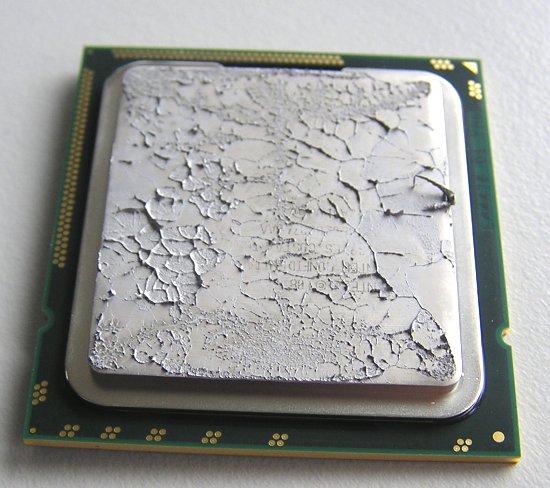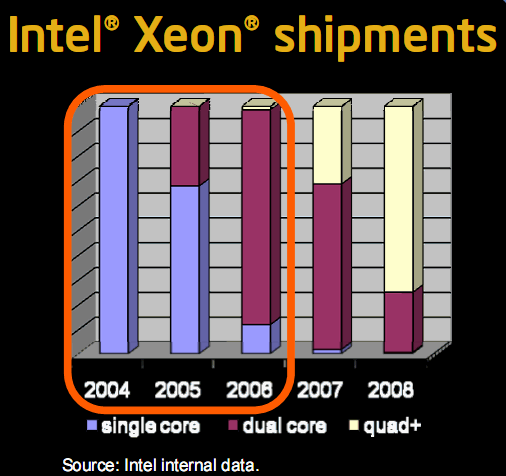The Best Server CPUs part 2: the Intel "Nehalem" Xeon X5570
by Johan De Gelas on March 30, 2009 3:00 PM EST- Posted in
- IT Computing


That means that Intel's Nehalem platform (and AMD's Shanghai/Opteron 23xx platform) has to convince people to replace their dual-core Opteron, dual-core Xeon 50xx ("Dempsey"), and Xeon "Irwindale" servers. There are two great ways to turn a much more powerful server into a moneymaking and cost saving machine. One is to use fewer servers in a cluster, which is not applicable to all companies. The other more popular approach is to consolidate more servers on the same physical machine by using virtualization. The most important arguments for upgrading your servers are performance/watt and support for virtualization.
Intel's newest platform holds the promise that it supports virtualization better by adding EPT and lower world switch times. However, probably the largest bottleneck in the past was the amount of available bandwidth. Bandwidth is frequently an overrated performance factor, as few applications - excluding the HPC world - get a boost from for example using three instead of two memory channels. That changes dramatically when you are running tens of virtual machines on top of a physical machine: many applications with medium bandwidth demands morph into one big bandwidth-hogging monster. The challenge is thus to provide access to the memory as fast as possible, lower energy consumption, and better support for virtualization. On paper, the Nehalem architecture definitely can play all those trump cards. Anand has provided a detailed description of the Nehalem architecture. The most important improvements for business applications are:
- The integrated memory controller talks to its own local memory or remote memory (NUMA). Memory access takes between 27 and 54 ns (80 to 161 cycles). Compare this to the Xeon 5450 at the same clock speed where memory access via the MC in the chipset can take up to 123 ns! The closest competitor (Opteron "Shanghai") needs between 32 and 71 ns.
- A native quad-core design with fast 33 cycle L3 cache make it easy for the L2 caches to exchange cache coherency information
- Fast CPU interconnects make sure that the rest of the snoops happen very fast and do not interfere with other traffic.
- The memory controller has up to three channels. A dual CPU configuration has access to 35GB/s of memory bandwidth (measured with stream) if you use DDR3-1333. The latest dual Opteron achieves 19.4GB/s with DDR2-800
Basically, Nehalem is Intel's version of the improvements found in the AMD Barcelona platform, only better (or at least that's the goal). Let's see what it can do in reality.










44 Comments
View All Comments
Veteran - Wednesday, April 1, 2009 - link
I didn't mean to offend you, because i can imagine how much time it takes to test hardware properly. And i personally think that OLTP/OLAP testing is very innovative and needed. Because otherwise people would have no idea what to buy for servers. You cannot let you server purchase be influenced with meaningless (for servers) simple benchmarks like 3D 2006/Vantage/FPS test etc.You guys always are doing a great a job at testing any piece of hardware, but it is just feeling to much biased towards Intel. For example, at the last page of this review you get a link to Intel resource Center (in the same place as the next button). If you have things like that, you are not (trying to be) objective IMO.
JohanAnandtech - Wednesday, April 1, 2009 - link
Thank you for clarifying in a very constructive way."the last page of this review you get a link to Intel resource Center"
I can't say I am happy with that link as it creates the wrong impression. But the deal is: editors don't involve in ad management, ad sales people don't get involved when it comes to content.
So all I can say is to judge our content, not our ads. And like I said, it didn't stop us from claiming that Shanghai was by far the best server CPU a few months ago. And that conclusion was not on many sites.
Veteran - Wednesday, April 1, 2009 - link
Thanks for clarrifying this matter.But ad sales people should know this creates the wrong impression. A review site (for me at least) is all about objectivity and credibility. When you place a link to Intel's Resource Center at the end of every review, it feels weird. People on forums already call Anandtech, Inteltech. And i don't think this is what you guys want.
I always liked Anandtech since when I was a kid, and I still do. You guys always have one of the most in-depth reviews (especially on the very technical side) and I like that. But you guys are gaining some very negative publicity on the net.
BaronMatrix - Tuesday, March 31, 2009 - link
Unfortunately, I don't buy from or recommend criminals.carniver - Wednesday, April 1, 2009 - link
AMDZone is the biggest joke on the internet. I just went there to see how the zealots like abinstein are still doing their damage control; just like before he went on rambling how the Penryn is still weak against Shanghai, and the old and tired excuses like how if people all bought AMD they can drop in upgrades etc etc. ZootyGray...he's the biggest joke on AMDZone. None of them had the mental capacity to accept AMD has been DEFEATED, which is disappointing but funny to say the leastduploxxx - Wednesday, April 1, 2009 - link
It's not just AMDZone, you are just the opposite. Its like in Woodcrest and conroe times, it's not because the high-end cpu is the best of all that the rest of the available cpu's in the line is by default better. It's all about price performance ratio. Like many who were buying the low-end and think they had bought the better system, well wrong bet.As mentioned before, why not test the mid range that is where the sales will be. Time to test 5520-5530 against 2380-82 after all those have the same price.
carniver - Wednesday, April 1, 2009 - link
Your argument is valid, however, it just so happens that for low end 1S systems the Penryns are doing just fine against the Shanghais, for higher end 2S systems they used to be limited by memory bandwidth and AMD pulls ahead. No more is this the case, Intel now beats AMD in their own territory.CHADBOGA - Tuesday, March 31, 2009 - link
You probably also can't afford to buy a computer, so I doubt that Intel will be too concerned with your AMDZone insanity. LOL!!!!smilingcrow - Tuesday, March 31, 2009 - link
Those grapes you are chewing on sure sound sour to me. Try listening to a few tracks by The Fun Loving Criminals to help take away the bad taste.cjcoats - Tuesday, March 31, 2009 - link
There's more to HPC applications than you indicate: environmental modeling apps, particularly, tend to be dominated by memory access patterns rather than by I/O or pure computation. Give me a ring if you'd like some help with that -- I'm local for you, in fact...